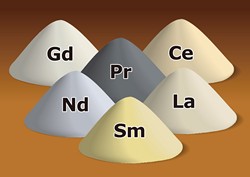Ionic liquids help to reclaim rare earth metals
Conventional methods for mining and recycling REMs are extremely costly and have a significant environmental impact because of the use of toxic chemicals and the large number of separation stages required. Current techniques based on liquid-liquid separations (hydrometallurgy) rely on organic solvents such as kerosene and n-heptane, which are highly volatile and flammable. The EU-funded REMSIL (Rare earth metal separation with ionic liquids) project addressed these challenges by developing novel, highly selective extractants for REM separation using ILs with two orders of magnitude higher selectivity. Multifunctional amide ionic liquids (MAILs) offered a groundbreaking alternative to organic solvents thanks to their excellent extractability and a very high factor for REM intra-group separation. Due to their ionic nature, MAILs are non-volatile and non-flammable, unlike conventional extractants. Researchers therefore synthesised and tested a new class of MAIL, which demonstrated excellent extractability and very high separation factors for REM intra-group separation compared to current techniques. The result was an ideal separation process that resulted in a new, cost-efficient and environmentally friendly process for REM separation, with the potential to change the way these metals are processed. Furthermore, the use and consumption of strong acids was significantly reduced as the system functions at moderate pH conditions. High recyclability and low levels of leaching and emulsification compared to other extractants was also demonstrated. The extractants developed by REMSIL have the potential to drastically lower processing costs by reducing the number of separation stages by more than one order of magnitude (from around150 stages to 10-15 stages). They also use non-toxic extractants, thereby decreasing the environmental impact of REM separation. REMSIL led to the development of a pilot-scale process that will employ these new extractants and establish a continuous flow system for the separation of REMs in order to demonstrate the full commercial potential of this process.







